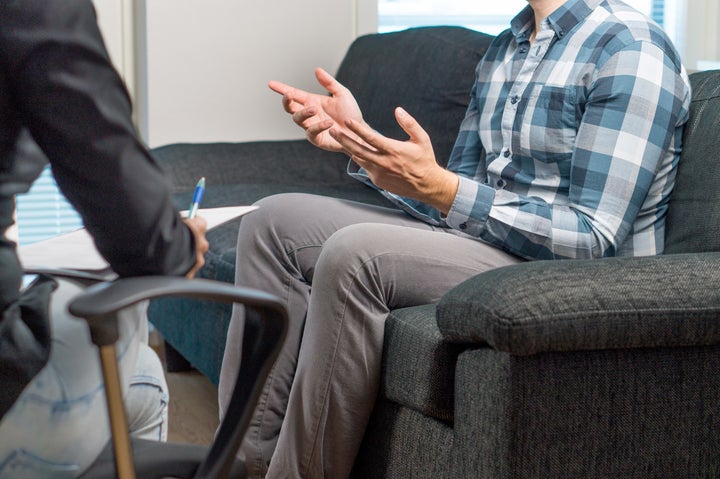
Note to readers: This essay contains graphic and disturbing content.
I was 14 and working as a babysitter when the thoughts first came.
What if I wanted to harm the kid I was caring for? What if I went into his room while he was sleeping and hurt him?
Logically, I knew I didn’t want to abuse this kid or any other. But the thoughts were smarter than I was. They were tricky and had a rebuttal for every reassurance I gave myself.
Perhaps you’ve already harmed him, the thoughts hinted. Perhaps you did it blacked out in a dissociative trance and that’s why you can’t remember it. Perhaps you so badly traumatized yourself hurting this child that you’ve blocked the memories.
Panic accompanied my thoughts and only made things more confusing. The kid was sleeping, he was safe. But the thoughts didn’t care. Check again and again, they told me. Every time I peeked in on the kid, he was fine. That didn’t stop the thoughts, though. Or the panic. Actually, it exacerbated both.
Summer break came, but brought no relief from the terrifying images of harming people. I lived for months in a haze of simmering panic. My parents went on vacation: What if I raped and murdered the woman who was taking care of me? I went to visit family: What if I started sleepwalking and went after my cousins?
It was a lot of pressure for a young teenager.
When I learned to drive, every bump in the road became a child on a bike. I’d circle around the block to check for blood in the street or a mangled Huffy, sometimes more than once. I looked up police accident reports for months and months, just to make sure there were no unsolved hit and runs.
I knew I couldn’t tell anyone about what I was thinking and feeling. They might think I was dangerous or crazy. Maybe they would call the police or send me to a mental hospital. Maybe both.
Living with such a strange secret was suffocating. I tried my best to hide it, but my parents could tell I was upset. Still, I never told them what I was thinking. Instead, I just swallowed the panic and charged on as well as I could.
Later, in my 20s, living in New York, I was surrounded by potential “targets” I feared harming.
What if I got on this train car and assaulted that little kid on his way to school? What if I contracted genital warts and passed it on to the woman I was dating and she developed cervical cancer? Better take a different train, better go to the free clinic, just to be sure.
I couldn’t eat. I couldn’t socialize. I couldn’t work. I couldn’t take it.
By the time I was almost 30, my intrusive thoughts became so painful, I knew I’d have to either kill myself or seek therapy. I didn’t want to devastate my family, so I decided I’d test out therapy first. It was so intimidating to try and explain the thoughts to someone else.
But I did. I sat there before a kind therapist and told my secrets to someone for the first time. Mercifully, he understood, offering empathy and professional support. It was a massive relief. Still, this therapist was not an expert in OCD, particularly the more subtle kind I had. He did help me, but it was clear he didn’t know how to fully treat these kinds of thoughts. Thankfully, he didn’t think I’d acted on any of these thoughts, or that I would, or that I was insane. But he didn’t know what else to do, and ultimately my first round of therapy sputtered out. I remained anxious and haunted by thoughts of hurting people.
In desperation, I searched the Internet for some story that sounded like mine. And then, after years, I finally found one. It was on a Wikipedia page titled “Intrusive Thoughts.” The entry said that most people had terrifying thoughts, but that some fixated on them. Particularly those who have a lesser-known form of OCD called Primarily Obsessional Obsessive Compulsive Disorder.
Known as “Pure O,” this disorder presents itself without the obsessive ritualization so commonly associated with OCD. Those of us with Pure O aren’t hand washers. We don’t have to count how many times we’ve flipped the light switch on and off. Pure O is all in the mind.
Pure O, I also learned, preys upon sufferers’ worst fears and most cherished values. An empath like myself is terrified they might become dangerous and harm someone. A devoutly religious person is haunted by blasphemous thoughts. A loving new father worries he’ll molest his infant son while giving him a bath. Someone else becomes terrified they’re “turning” gay. Further, those with Pure O may fear they’ve already acted out their worst thoughts, even though logic says otherwise.
I could relate to all of that. It was the first time I’d ever read anything approximating my experience. The thoughts and panic remained, but at least I was no longer completely alone.
Pure O, I learned, is pernicious and hard to shake, but thankfully straightforward to treat. A specialized type of cognitive behavioral therapy focused on exposure to one’s frightening thoughts works best. Though it’s terrifying to begin this treatment, in which the sufferer faces their worst fears over and over again, repeated exposure to an intrusive thought at the hands of a trained therapist eventually lessens its impact. As the brain and body learn that intrusive thoughts aren’t actual threats, the patient becomes desensitized to them, ultimately managing their fears and interrupting the cycle of panic and reassurance-seeking that fuels Pure O.
I was lucky to find a cognitive behavioral therapist specializing in Pure O therapy. Treatment was scary and grueling, but my therapist believed in me and I refused to give in. My therapist coached me to lean into an intrusive thought when it popped up, advising me to relish the gory details while I sat through the panic to get to the other side.
I learned that it’s the avoidance that teaches the body that a thought is an actual bodily threat. Every time one tries to shake their intrusive thoughts, it only makes them stronger, confirming that the body was right to respond with panic, fueling an ever-amplifying cycle of anxiety.
Over a couple years, my therapist and I worked our way up, intensifying the exposures. I found a news article about children being abused, and read it every day. Eventually, I wrote a “confession” letter, detailing my worst “crimes,” and read that over and over, too. By exposing myself to these thoughts, and sitting through the fire of panic until it subsided, I learned to manage my Pure O.
It’s been a few years since I stopped therapy, and though the intrusive thoughts still come occasionally, I have the tools to handle them now. I haven’t had a panic attack in a long time. While managing my Pure O is an ongoing thing, it’s no longer at the forefront of my mind. Though I know life and its tragedies can propel a Pure O sufferer back into a cycle of intrusive thoughts, avoidance and panic, I still feel confident that I now have the skills to manage something like that. And, if not, I know where to go to get more help if I need it.
I can’t believe how much the proper treatment changed my life. I no longer feel isolated and alone. I still have anxiety, but it’s no longer toxic and life-crushing. Unwanted thoughts of harming people no longer choke the breath out of me. They come, I acknowledge them, and then they go. I’m incredibly grateful.
Since I concluded my treatment, Pure O has gained more and more recognition among mental health professionals and the general public. OCD Online is a great place to start if you think you might be dealing with Pure O. Don’t be afraid. Take a look, and know that you’re not the only one out there.
